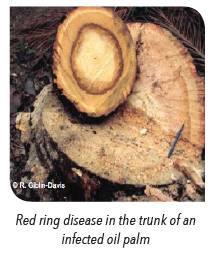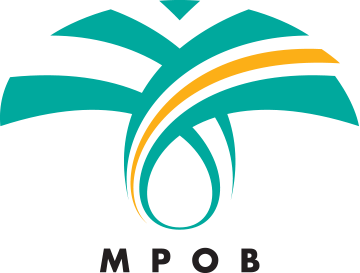General Information

Limnobaris calandriformis are attracted to host palms damaged by pruning and bad harvesting practices. L. calandriformis is present immediately once host palms sustain wounds (e.g. after cutting leaves).
L. calandriformis is a potential vector for the red-ring disease nematode, Rhadinaphelenchus cocophilus. Palms infected with the red-ring nematode usually die within a few months (2-4 months). Up 10%-15% losses is incurred annually on infested plantations. Heaviest losses occur at the end of the wet season and in the first 2 or 3 months of the dry season. The characteristic symptom of infection is a red, concentric ring that extends throughout in the stem. Other visible symptoms include decline in fruit production, premature nutfall, yellowing and aging of fronds, and the “little leaf syndrome” where fronds are stunted in growth. Red streaks may appear in the petioles, and the roots may turn orange to faint red and become dry and flaky. There is no known treatment for the red-ring disease.
Distribution
South America
Prevention and Control
PHYTOSANITARY
The import of germplasm material (seeds, pollen, tissue culture) must be accompanied by an import permit issued by or on behalf of the Director-General of Agriculture for Peninsular Malaysia (including Labuan), or the Director of Agriculture for Sabah, and a phytosanitary certificate issued by an authorised official from the country of export. The import conditions are available upon request from the Plant Biosecurity Division Malaysia. All consignments are subjected to inspection by the Agricultural Department prior to clearance by Customs. Germplasm material imported from high risk areas should be sent for third country quarantine before arrival onto Malaysian shores.
CULTURAL CONTROL AND SANITARY METHODS
i) Palm inspection;
ii) bait traps;
iii) proper disposal of pruning and harvest wastes.
Further reading
- Evans, G (2005). Developing Biosecurity Plans: Risk mitigation, and research & development. Proc. of the APEC Workshop on Building Biosecurity Planning and Surveillance Capacity for APEC Member Economies, Kuala Lumpur, Malaysia. 167 pp.
- Giblin-Davis, R (undated). Biology and management of palm weevils. University of Florida/IFAS. Fort Lauderdale Research and Education Centre.
- Guerrero, H C; Toguica, S M and Avila, L A G (1995). Red ring – Little leaf in oil palm. Technology available in Colombia. Palmas 16(Special issue): 211-218.

